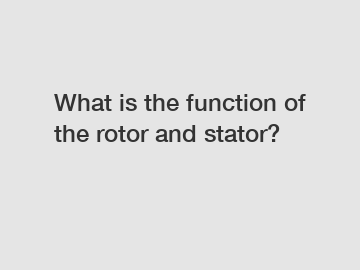What is the function of the rotor and stator?
Goto CHME to know more.
The Function of the Rotor and Stator in an Electric Motor.
Electric motors are essential components in a myriad of machines and devices that we use in our daily lives. These motors consist of two key parts - the rotor and stator. The rotor is the rotating component of the motor, while the stator is the stationary part that surrounds the rotor. Both the rotor and stator play crucial roles in the operation of an electric motor.

Understanding the roles of these two components can help us appreciate how electric motors work and how they power various applications.
Stator Function.
The stator is the stationary part of an electric motor that surrounds the rotor. It is typically made up of coils of wire wound around an iron core. The stator's primary function is to generate a magnetic field that interacts with the magnetic field produced by the rotor. When an electric current flows through the stator windings, it creates a magnetic field that exerts a force on the rotor, causing it to rotate.
The stator's magnetic field is essential for converting electrical energy into mechanical energy, driving the rotation of the rotor. It provides the necessary torque to turn the rotor, allowing the motor to perform useful work.
Rotor Function.
The rotor is the rotating part of an electric motor that is connected to the shaft. It is typically made up of a series of windings or permanent magnets that interact with the magnetic field produced by the stator. As the stator's magnetic field exerts a force on the rotor, it causes the rotor to rotate, converting electrical energy into mechanical energy.
The rotor's rotation drives the output shaft of the motor, allowing it to power various applications such as pumps, fans, compressors, and more. By converting electrical energy into mechanical energy, the rotor plays a crucial role in the operation of an electric motor.
Interaction Between Rotor and Stator.
The interaction between the rotor and stator is critical for the proper functioning of an electric motor. The stator's magnetic field exerts a force on the rotor, causing it to rotate and generate mechanical energy. The rotor's motion, in turn, creates a back electromotive force (EMF) in the stator windings, which helps regulate the motor's speed and performance.
The seamless interplay between the rotor and stator determines the motor's efficiency, torque, and speed capabilities. By optimizing the design and construction of these two components, manufacturers can improve the overall performance and reliability of electric motors.
Conclusion.
In conclusion, the rotor and stator are integral components of an electric motor, each playing a crucial role in converting electrical energy into mechanical energy. The stator generates a magnetic field that interacts with the rotor, causing it to rotate and drive the motor's output shaft. Understanding the functions of the rotor and stator can provide valuable insights into how electric motors work and how they power various applications.
If you have any questions about electric motors or need assistance with rotor or stator repairs, please feel free to contact us. Our team of experts is here to help you with all your motor-related needs.
Contact us for more information or to schedule a consultation.
You can find more information on our web, so please take a look.
For more information, please visit Bus motor core.



